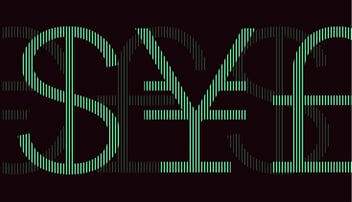
Gain an overview of the latest developments on the currency market and anticipate fluctuation risks.
EUR/USD
High: 1.2350 / Low: 1.2000 / Variation: -1.93%
A downturn for the EUR/USD this month, as European economies struggle to cope with further strict lockdowns in an attempt to contain new Covid-19 variants. This is likely to result in further shrinkage across the eurozone for the first quarter of this year. Although in its last meeting the ECB stood behind its previous forecast of 3.9% growth for 2021, many analysts now believe that this figure is on the optimistic side.
Given the ongoing uncertainties over Europe’s ability to vaccinate its population quickly, notably due to national-level issues, as well as supply and/or logistic problems, you have a perfect recipe for a fall in the single currency. It seems ever more likely that the consensus was far too optimistic towards the end of 2020 regarding the likelihood of economic recovery in 2021.
On the other hand, although the US is still battling a tricky situation with regard to the pandemic, it ought to benefit from a massive fiscal stimulus package of $1.9 trillion (USD). The major elements of this package will be put to a vote in the coming weeks.
EUR/GBP
High: 0.9086 / Low: 0.8795 / Variation: -2.13%
As with the dollar, the euro has lost a lot of ground this month against the pound sterling. Setbacks in the European vaccination programme, in contrast to the impressive performance put in by the UK, combined with yet further restrictions in several countries, are largely responsible for this fall in the single currency.
When it comes to monetary policy, the Bank of England is due to meet on 4 February, but the exchange rate market is not expecting any changes. In other words, a base rate kept at 0.10% and further quantitative easing (QE) to the tune of £875 billion (GBP) are both expected. Just a few weeks ago, people were still mooting negative rates (especially one member of the Bank of England’s Monetary Policy Committee, Silvana Tenreyro), but this option appears to have once again been taken off the table.
EUR/JPY
High: 127.50 / Low: 125.08 / Variation: +0.02%
The past month has seen a 250-point fluctuation in the EUR/JPY pair. The market continues to react to statements from Europe on the pandemic front, and the risk of a new European recession explains why the euro has performed so badly in comparison with the Japanese yen.
Monetary policy has had little impact over the past few weeks because both Japan and the eurozone appear to be running on autopilot. However, we note the stark warning from the Japanese banking lobby, which has been urging the Bank of Japan not to depress negative interest rates further, fearing it could jeopardise the profitability of the entire sector.
EUR/CHF
High: 1.0869 / Low: 1.0738 / Variation: +0.15%
Although the Swiss National Bank would clearly prefer a higher EUR/CHF rate above the 1.10 range, this month’s performance is unlikely to cause Bern to break into a cold sweat. The pair continues to hover around the 1.07-1.08 mark, without the central bank needing to take any notable action on the currency market.
The absence of any major geopolitical risks, despite the downturn in the pandemic across the eurozone, is one of the reasons behind the stability of this pair. Once Europe recovers from the pandemic, towards the third quarter at the latest, the pair is likely to spring back to a much healthier level.
EUR/CAD
High: 1.5681 / Low: 1.5267 / Variation: -1.76%
The sharp fall in this pair in recent weeks is due to the double whammy of a continued rise in oil prices over January (+8% for Brent and WTI over the course of the month), which usually benefits the Canadian dollar, plus setbacks regarding the pandemic and Europe’s vaccination programme. As regards monetary policy, the Bank of Canada has kept its base rate at 0.25%, while continuing its quantitative easing at a rate of $4 billion (CAD) a week.
Although the Canadian economy looks set to shrink in the first quarter, leading to a fall in growth forecasts to 4% this year, the central bank sees no reason to adjust its strategy. Indeed, the Bank of Canada is closely following the example set by central banks of several other developed countries, currently running on autopilot, which we predict will continue at least until mid-2021.
EUR/AUD
High: 1.6031 / Low: 1.5593 / Variation: -1.38%
The big surprise this February comes from Australia, whose central bank has decided to extend its programme of quantitative easing, once the current round comes to an end in April. This decision should support efforts to curb the rise in unemployment, although the figures are in fact lower than feared given the circumstances. According to analysts, there is every chance that the current QE policy will continue, possibly even until 2024.
EUR/CNH
High: 7.9535 / Low: 7.8184 / Variation: +1.01%
In recent weeks, the downturn in the euro has been felt across the board, including by the CNH. The differences not only in how these two regions are managing the health crisis, but also in their growth forecasts, are clearly benefiting the CNH more than the euro. While there is no doubt that the eurozone has entered into a new recession, the Chinese economy continues to recover, with growth of 2.3% last year and optimists forecasting a possible 8% this year. This difference is likely to remain a key element in interpreting the EUR/CNH exchange rate over the coming months.
EUR/HUF
High: 365.29 / Low: 354.67 / Variation: -1.69%
As we entered into 2020, the EUR/HUF had plummeted by 330 points. Then the pandemic took hold, and the value of the Hungarian currency slumped against the euro, with the pair reaching the dizzy heights of 370. The start of 2021 saw a slight dip in the single currency almost across the board, primarily due to concerns over how the eurozone is managing the pandemic. In terms of monetary policy, both the ECB and the Hungarian Central Bank are sticking to the status quo.
The latter is likely to continue its accommodative bias over the medium term. The main base rate is unlikely to change, and if there is to be any shift at all in monetary policy, it will probably be at deposit rate level. Furthermore, the Hungarian Central Bank is actually welcoming the current change in the EUR/HUF pair because a weak currency should generate valuable support for the government’s policy of betting on exports to restart the economy.
Economic calendar:
| DATE | CURRENCY | EVENT |
|---|---|---|
| 04/02 | GBP |
Central bank meeting |
| 05/02 | USD |
US Jobs (NFP) Report for January |
| 12/02 | CNH |
Chinese New Year |
| Mid-February | USD |
Congress to vote on the Biden administration’s recovery plan (worth $1.9 trillion) |
Topics




